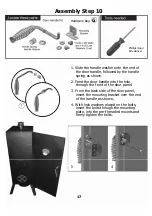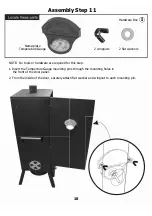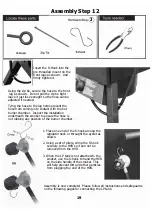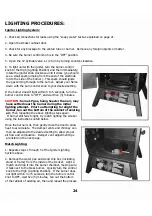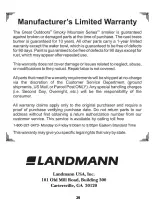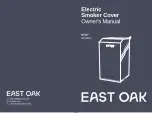
To add wood chips before smoking, fill the wood chip box with your choice of flavoring hardwood chips. The
amount and type of wood you use is entirely up to you. One full filling of the wood chip box is typically enough
for several hours of smoking. Once the wood chip box is filled, place the lid on top of the wood chip box and set
the box into the correct location of the smoker. For one door smokers, the wood chip box should be either placed
on the wood chip box stand or frame, whichever is applicable. For two drawer smokers, the wood chip box
should be placed in the lower drawer that has a frame specifically designed for the wood chip box.
COOKING TIPS - Flavored woods:
* Small wood chips work best inside the wood chip box.
* Use dry hardwoods such as hickory, pecan, apple, cherry or mesquite.
* Most fruit and nut tree woods produce an excellent smoke flavoring.
* Do not use resinous woods such as pine. These usually product unpleasant flavoring.
* Let our tast be your guide - experiment with different types and quantities of wood chunks, chips or sticks.
You also mix woods.
* To produce more smoke and prevent fast burning, pre-soak the wood chips in a separate bowl of water for
at least 30 minutes, or wrap the chips in perforated aluminum foil. [See wood chip manufacturer’s instructions]
* Most smoker flavoring occurs within the first hour of cooking. Adding wood chips after the first hour is
typcially not necessary unless extra smoke flavoring is desired.
THE WOOD CHIP BOX AND LID WILL GET VERY HOT DURING SMOKING. AVOID HANDLING THEM
WHILE IN USE. ALWAYS WEAR PROTECIVE OVEN MITTS WHEN HANDLING HOT COMPONENTS.
CHIMNEY AND DAMPER VENT ADJUSTMENTS
Temperature maintenance is best controlled by different chimney and side damper adjustments. The key to
effective smoking is to watch your heat indicator (temperature gauge) on the door and adjust the chimney and
side dampers accordingly.
* For better performance, rotate the smoker to where the front or boack of the smoker is facing the wind. This
allows the adjustment of the chimney and side damper vents to be more effective and accurate.
* Opening the chimney and side damper vents helps to exhaust both heat and smoke.
* The chimney and side dampers vents
SHOULD
NEVER
BE FULLY CLOSED.
* Opening the side damper vents allows more oxygen to be consumed by the fire, fueling flames and causing an
increase in temperature.
* Temperature maintenance is best controlled by different chimney and side damper adjustment configurations.
CAUTON
23
ADDING WOOD CHIPS









